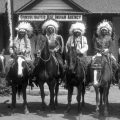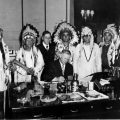( – promoted by navajo)
The United States acquired what would become Colorado and Utah from Mexico following a brief war in 1848. In the treaty of Guadalupe Hidalgo, the United States agreed to recognize Indian land holdings and to allow Indian people to continue their customs and languages. At this time, the primary Indian tribes in Colorado were the Ute, Comanche, Arapaho, and Cheyenne. It was not long, however, before the American settlers in Colorado began to advocate that all Indians be removed from the territory so that the land could be developed for cattle, farming, and mining by non-Indians.
In 1880, the American government forced the Whiteriver Ute to agree to move to the Uintah Reservation in Utah where they were to live with other Ute bands. Under the agreement with the federal government, the bands were to have a perpetual trust fund created from the sale of their Colorado homelands. The United States, however, makes no attempt to sell the Ute lands and they remain in government possession.
American greed for land and minerals caught up with the Ute in Utah. Soon American settlers were advocating the opening of the Uintah Reservation to non-Indian settlement. Without consulting the Ute, in 1903 Congress passed an act to allot the Uintah Reservation. Under allotment, tribal members would be given parcels of land for “farming” and the remainder of the reservation opened for non-Indian settlement. The Ute protested the act.
In 1905, a non-Indian commission selected the allotments for the Ute in the Uintah Valley. The least valuable lands on the reservation were allotted and the remaining lands, the best farm lands, were opened for homesteading by non-Indians. The Utah Mormons met and held a drawing for the best lands in the valley.
In addition to opening the reservation, a Presidential proclamation took 101,000 acres from the Ute and added it to the Uintah National Forest. An additional 60,120 acres were set aside for reclamation and reservoir purposes.
Many of the Utes, particularly those from the Whiteriver bands, were upset about the allotment of their reservation and the increase of non-Indian settlers. Red Cap spoke to the Ute who had gathered for the 1906 Bear Dance:
“The white people have robbed us of our cattle, our pony grass, and our hunting grounds”
As a result of his encouragement, between 300 and 600 gathered with their wagons, supplies, and horses near present-day Bridgeland. They planned to travel to Montana and South Dakota, where they hoped to form an alliance with the Sioux and with the Crow and to stop the allotment program.
Initially their journey took them into Wyoming where one dispatch reported:
“Seven hundred Utes are slaughtering cattle and sheep, robbing ranches and committing other depredations in the vicinity of Douglas, on the Platte River 150 miles north of Cheyenne. They are in an ugly mood and refuse to return to their reservation at White Rocks, Utah.”
The governor of Wyoming telegraphed the Commissioner of Indian Affairs to have them removed. The Commissioner replied:
“As long as they [the Indians] are peaceful and do not threaten hostility it does not seem that the Federal government would be justified in interfering with them.”
A special inspector from the Bureau of Indian Affairs met with the Ute and persuaded 45 of them to return to the reservation. He reported that about 100 were planning to go to the Big Horn Mountains to settle and the rest were bound for Pine Ridge, South Dakota.
On their journey, the Utes were peaceful. They killed game, but they felt that the game belonged to Indian people. In spite of the newspaper accounts, there was no violence toward non-Indians. The governor, however, reported that the Indians were drinking, insulting and stealing. He demanded federal help. The President sent his request to the War Department. Two detachments of the Tenth Cavalry were sent to meet with Red Cap.
The army made a strong show of force and the Indians saw the hopelessness of their situation. The military then escorted them to Fort Meade, South Dakota. In spite of court rulings indicating that Indians were entitled to due process of law, the army assumed that the Utes were prisoners of war.
In South Dakota, the Ute found that the Sioux have no interest in entering into an alliance with them. The Sioux were facing difficult times. The army placed the Ute band on the Cheyenne River Sioux Reservation.
With regard to the Ute situation, the Commissioner of Indian Affairs recommended not feeding them. In a speech to the Lake Mohonk Conference he said:
“It was not the government’s fault that they took the course they did in order to get into a place where they could live in idleness and eat the bread of charity. If they persist in that course they will be made to understand what the word ‘must’ means.”
His words are met with a round of applause.
In 1908, the Ute who had gone to the Cheyenne River Sioux Reservation in South Dakota were returned to the Uintah reservation in Utah under military escort. The Ute leaders were defeated and discouraged. They were unable to control the destiny of their people. The American government dictated their destiny with no concern for possible Constitutional rights, even though the courts had consistently ruled that Indians were entitled to those rights.
![]()




Leave a Reply